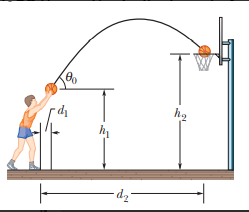
At what initial speed must the basketball player in fig throw the ball, at angle ${{\theta }_{0}}={{55}^{0}}$ above the horizontal, to make the foul shot? The horizontal distances are ${{d}_{1}}=1.0ft$ and ${{d}_{2}}=14ft$ , and the heights are ${{h}_{1}}=7.0ft$ and ${{h}_{2}}=10ft$.


Answer
496.8k+ views
Hint: Speed is defined as the distance covered per unit time and speed is a scalar quantity. SI unit of speed is $m{{s}^{-1}}$. Displacement is defined as the process in which objects' positions are changed and in displacement the initial position of objects are changed. Displacement is also defined as change in initial position of objects to the final position and displacement is denoted as S.
Complete step-by-step solution:
Displacement is a vector quantity which has both magnitude and direction and displacement is measured in terms of meters. The dimensional formula of displacement is ${{M}^{0}}{{L}^{1}}{{T}^{0}}$ and displacement plays a very important role while determining velocity (v). Velocity is also a vector quantity.
Velocity is defined as the rate of change of displacement with respect to time and in kinematics velocity is a fundamental concept. SI unit of velocity is $m{{s}^{-1}}$ and velocity tracking is the measure of velocity.
Velocity (v) =$\dfrac{\Delta S}{\Delta t}$
The dimensional formula of velocity is ${{M}^{0}}{{L}^{1}}{{T}^{-1}}$.
The force which causes a change in velocity and change in velocity creates a force.
We know that
${{v}_{0}}=\dfrac{x}{\cos {{\theta }_{0}}}\sqrt{\dfrac{g}{2(x\tan {{\theta }_{0}}-y)}}$ $\cdots \cdots (1)$
From the data $g=32ft{{s}^{-2}}$, $x=13ft$, $y=3ft$ and ${{\theta }_{0}}={{55}^{0}}$
Substituting these values in equation (1)
${{v}_{0}}=\dfrac{13}{\cos {{55}^{0}}}\sqrt{\dfrac{32}{2(13\tan {{55}^{0}}-3)}}$
We get ${{v}_{0}}=23ft{{s}^{-1}}$
Note: Acceleration depends on the mass and also on the force. The force velocity, acceleration and momentum have both magnitude and a direction. Heavier objects have less acceleration compared to lighter objects. Newton’s second law of motion to relate the motion of the object to the forces involved. Objects with constant masses are used in Newton’s second law.
Complete step-by-step solution:
Displacement is a vector quantity which has both magnitude and direction and displacement is measured in terms of meters. The dimensional formula of displacement is ${{M}^{0}}{{L}^{1}}{{T}^{0}}$ and displacement plays a very important role while determining velocity (v). Velocity is also a vector quantity.
Velocity is defined as the rate of change of displacement with respect to time and in kinematics velocity is a fundamental concept. SI unit of velocity is $m{{s}^{-1}}$ and velocity tracking is the measure of velocity.
Velocity (v) =$\dfrac{\Delta S}{\Delta t}$
The dimensional formula of velocity is ${{M}^{0}}{{L}^{1}}{{T}^{-1}}$.
The force which causes a change in velocity and change in velocity creates a force.
We know that
${{v}_{0}}=\dfrac{x}{\cos {{\theta }_{0}}}\sqrt{\dfrac{g}{2(x\tan {{\theta }_{0}}-y)}}$ $\cdots \cdots (1)$
From the data $g=32ft{{s}^{-2}}$, $x=13ft$, $y=3ft$ and ${{\theta }_{0}}={{55}^{0}}$
Substituting these values in equation (1)
${{v}_{0}}=\dfrac{13}{\cos {{55}^{0}}}\sqrt{\dfrac{32}{2(13\tan {{55}^{0}}-3)}}$
We get ${{v}_{0}}=23ft{{s}^{-1}}$
Note: Acceleration depends on the mass and also on the force. The force velocity, acceleration and momentum have both magnitude and a direction. Heavier objects have less acceleration compared to lighter objects. Newton’s second law of motion to relate the motion of the object to the forces involved. Objects with constant masses are used in Newton’s second law.
Recently Updated Pages
Master Class 12 Economics: Engaging Questions & Answers for Success

Master Class 12 Maths: Engaging Questions & Answers for Success

Master Class 12 Biology: Engaging Questions & Answers for Success

Master Class 12 Physics: Engaging Questions & Answers for Success

Master Class 8 Maths: Engaging Questions & Answers for Success

Class 8 Question and Answer - Your Ultimate Solutions Guide

Trending doubts
What is meant by exothermic and endothermic reactions class 11 chemistry CBSE

Which animal has three hearts class 11 biology CBSE

10 examples of friction in our daily life

One Metric ton is equal to kg A 10000 B 1000 C 100 class 11 physics CBSE

1 Quintal is equal to a 110 kg b 10 kg c 100kg d 1000 class 11 physics CBSE

Difference Between Prokaryotic Cells and Eukaryotic Cells




